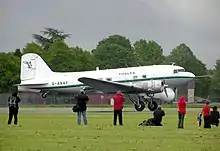
The Douglas DC-3 is a fixed-wing, propeller-driven aircraft which revolutionized air transport in the 1930s and 1940s, and is generally regarded as one of the most significant transport aircraft ever made.
The DC-3 was engineered by a team led by chief engineer Arthur E. Raymond and first flew on December 17, 1935 (the 32nd. anniversary of the Wright Brothers flight at Kitty Hawk). The plane was the result of a marathon phone call from American Airlines CEO C.R. Smith demanding improvements in the design of the DC-2. The amenities of the DC-3 (including sleeping berths on early models and an in-flight kitchen) popularized air travel in the United States. With just one refuelling stop, transcontinental flights across America became possible. Before the DC-3, such a trip would entail short hops in commuter aircraft during the day coupled with train travel overnight.
During World War II, many civilian DC-3s were drafted for the war effort and thousands of military versions of the DC-3 were built under the designations C-47, C-53, R4D, and Dakota. The armed forces of many countries used the DC-3 and its military variants for the transport of troops, cargo and wounded. Over 10,000 aircraft were produced (some as licensed copies in Japan as Showa L2D, and in the USSR as the Lisunov Li-2).
- Span: 95 ft (28.96 m)
- Length: 64 ft 5 in (19.65 m)
- Height: 16 ft 11 in (5.16 m)
- Engines: 2× Pratt & Whitney Twin Wasp S1C3G 14-cylinder radial engines, 1,200 hp (895 kW) or Wright Cyclone
- Cruising Speed: 170 mph (274 km/h)
- First Flight:December 17, 1935
- Number built: 13,140 (including license built types)